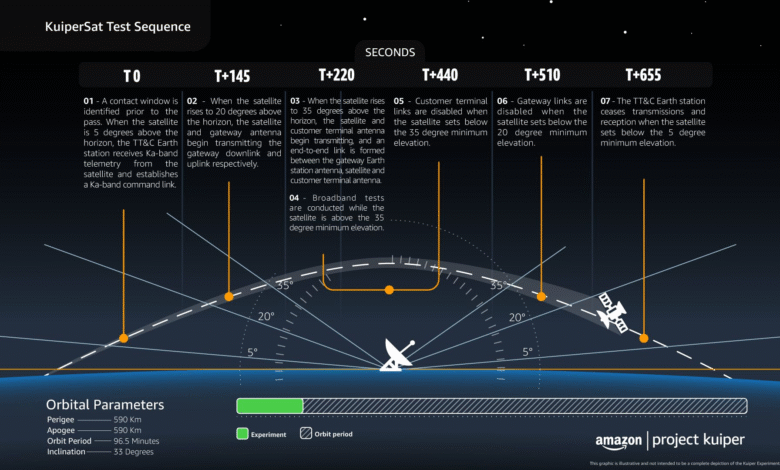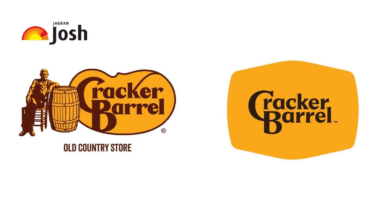Amazon Kuiper Satellites: Partnering with SpaceX for Launch

Amazon Kuiper satellites are poised to reshape the satellite internet market as part of Amazon’s ambitious Project Kuiper initiative. With a strategic partnership with SpaceX, Amazon is leveraging the expertise of Elon Musk’s company to launch its next batch of low Earth orbit satellites, aiming to bridge the gap with SpaceX’s established Starlink network. The first launch under this collaboration, set for the near future, will carry 24 of these Kuiper satellites into orbit, propelling Amazon into a fierce competition for global broadband internet access. With over 3,000 satellites planned, Amazon’s Kuiper internet project is focused on providing reliable connectivity, especially in underserved regions. As the market continues to expand, the success of these deployments could dramatically enhance Amazon’s position in the burgeoning satellite internet sector.
The Amazon Kuiper satellites represent a significant venture in the realm of satellite communications, aiming to deliver high-speed internet access across vast areas. Known as Project Kuiper, this initiative not only underscores Amazon’s dedication to innovation but also highlights its competitive edge against other players in the satellite internet field, notably SpaceX’s Starlink. By utilizing advanced technologies and a robust constellation of low Earth orbit satellites, Amazon seeks to democratize internet access for millions. As it embarks on this journey, the collaboration with SpaceX marks a pivotal moment that showcases how even rivals can align for mutual benefit in the space race. With investment pouring in, the potential for Kuiper to lead the market in satellite broadband by 2030 is becoming increasingly plausible.
Amazon Kuiper Satellites: A New Era in Satellite Internet
Amazon’s Project Kuiper represents a significant move into the satellite internet landscape, aiming to compete directly with SpaceX’s Starlink. With over 3,000 satellites planned, the Kuiper constellation is designed to provide broadband internet services globally, especially in underserved areas. This commitment underscores Amazon’s ambition to not only enhance its technological portfolio but also transform how millions access the internet, shifting the paradigm from traditional connections to satellite-based services.
The recent collaboration with SpaceX highlights both the urgency and the scale of the Kuiper initiative. As Amazon turns to SpaceX to launch its next batch of 24 Kuiper satellites, the partnership signals a strategic pivot to leverage established rocket capabilities for rapid deployment. This race is not just about launching satellites; it’s about securing a stake in a burgeoning market that could reach $40 billion by 2030.
The SpaceX Partnership: A Strategic Move for Amazon
In an unexpected turn of events, Amazon has decided to partner with its rival SpaceX for the launch of its Kuiper satellites. This collaboration illustrates the competitive dynamics in the satellite internet market, where speed and reliability often dictate success. While SpaceX has firmly established itself with its Starlink service, this partnership allows Amazon to accelerate its deployment timeline for Project Kuiper significantly.
Utilizing SpaceX’s Falcon 9 rockets, Amazon aims to quickly increase the number of satellites in orbit to meet Federal Communications Commission (FCC) deadlines. With the need to launch approximately 1,600 satellites by mid-2026, such partnerships are crucial. This strategic alliance could also pave the way for future collaborations in the rapidly evolving landscape of satellite communications.
The Challenge of Competing with Starlink
Amazon’s entry into the satellite internet sector highlights the fierce competition it faces from SpaceX’s Starlink. Starlink is currently the gold standard in low earth orbit satellite internet with thousands of satellites already operational and an expansive user base. With its robust first-mover advantage, SpaceX holds a significant lead in customer acquisition and service maturity, which challenges Amazon’s ambitions with Project Kuiper.
To catch up, Amazon must not only boost its satellite launch cadence but also ensure that its service delivers competitive speeds and reliability. As the company ramps up efforts, the quality of the broadband service offered by Kuiper will determine how rapidly they can win over customers who are already enjoying Starlink.
The Financial Implications of Project Kuiper
Amazon’s commitment to Project Kuiper is enormous, with initial estimates suggesting investments could reach $23 billion. This figure includes building out the satellite constellation and the necessary ground infrastructure to connect users. Financial analysts believe that the potential reward is significant, projecting a $7.1 billion revenue stream by 2032 if Amazon captures a reasonable share of the satellite internet market.
However, these ambitions come with risks. As the satellite internet market expands, Amazon will require consistent funding and strategic planning to achieve profitability. Costs incurred from satellite manufacturing and launching operations will have to be balanced against potential subscription revenues from customers eager to experience high-speed internet service.
Market Trends in Satellite Internet
With the growing demand for high-speed internet access across the globe, the satellite internet market is expected to surge past $40 billion by the end of the decade. This growth is fueled by the increasing need for connectivity in remote areas and the rising dependency on internet services for both personal and professional use. Companies like Amazon, through Project Kuiper, are strategically positioning themselves to tap into this lucrative market.
As satellite technology improves, consumers will also benefit from enhanced services. This shift towards satellite-based internet solutions is set to disrupt traditional broadband providers by offering flexible and accessible internet options. With Amazon’s backing and advanced technological capabilities, Project Kuiper is poised to play a pivotal role in shaping the future of global internet connectivity.
The Importance of Timely Launches for Amazon
Timely launches are essential for the success of Project Kuiper. The FCC has mandated that Amazon achieves a certain number of satellites in orbit by specific deadlines to maintain its license. With 1,600 satellites required by July 2026, each successful launch becomes a step closer to fulfilling regulatory requirements and establishing a presence in the competitive satellite internet landscape.
Moreover, the logistics of timely satellite deployment directly influence the project’s market entry speed. Every launch delays could result in lost opportunities and further widen the gap between Amazon’s Kuiper and SpaceX’s Starlink. As such, the collaboration with SpaceX is pivotal, ensuring that Amazon can continue its pace of launches to meet these tight deadlines.
Consumer Expectations for Kuiper Internet Service
As Amazon prepares to enter the satellite internet market with Project Kuiper, consumer expectations will play a critical role in shaping the service. Users will be looking for reliable, fast, and affordable internet options, especially those in remote or underserved regions. To succeed, Kuiper must not only match existing services like Starlink but also offer unique features that enhance the user experience.
The launch of its first satellites will be closely watched, and initial feedback could set the tone for how Amazon’s service is perceived in the competitive landscape. Thus, quality of service and customer support will be paramount, especially as the company strives to secure a loyal customer base in a market already dominated by established players.
Technological Advancements in Satellite Systems
The ongoing developments in satellite technology are essential for the success of projects like Amazon’s Kuiper. Innovations in miniaturization, capacity enhancement, and operational efficiency can lead to better performance and lower costs for satellite deployments. Effective communication systems, along with advanced propulsion technologies, are enabling companies to design satellites that are more efficient in delivering broadband services.
These advancements will not only benefit Amazon and its Kuiper project but will also catalyze growth across the satellite internet industry. As new technologies are embraced, the performance characteristics of satellite networks will improve, enhancing overall user satisfaction and expanding potential applications for satellite internet.
Project Kuiper’s Impact on Global Connectivity
The implications of Amazon’s Project Kuiper extend far beyond mere internet access; they could fundamentally alter the landscape of global connectivity. By bringing broadband services to remote and rural areas, Project Kuiper has the potential to bridge the digital divide, enabling millions to access educational resources, telehealth services, and online job opportunities for the first time.
Moreover, as competition intensifies in the satellite internet sector, users may benefit from better pricing and service options. Amazon’s involvement through Project Kuiper signifies a crucial step toward comprehensive global internet coverage, setting the stage for enhanced economic growth and social development in regions that have long been left behind.
Frequently Asked Questions
What is the Amazon Kuiper internet project?
The Amazon Kuiper internet project is an initiative by Amazon aimed at providing broadband internet services via a constellation of low Earth orbit satellites. Launched in 2019, Project Kuiper seeks to deploy over 3,000 satellites to enhance internet access, particularly in underserved areas.
How does Amazon Kuiper compare to SpaceX’s Starlink in the satellite internet market?
Amazon Kuiper is a competitor to SpaceX’s Starlink in the satellite internet market. While Starlink currently dominates with around 8,000 low Earth orbit satellites and five million customers, Amazon is rapidly expanding its Kuiper satellite constellation to offer similar services. As of mid-2025, Amazon has plans to launch additional Kuiper satellites to strengthen its market position.
Who is launching the next batch of Amazon Kuiper satellites?
The next batch of Amazon Kuiper satellites is being launched by SpaceX using its Falcon 9 rocket. Despite being competitors in the satellite internet market, Amazon has partnered with SpaceX for certain launches to expedite the deployment of its Kuiper satellites.
What are the key milestones for Amazon’s Project Kuiper?
Key milestones for Amazon’s Project Kuiper include launching the first two demonstration satellites in October 2023 and aiming to deploy a total of 1,600 satellites by the end of July 2026. The ambitious timeline is set by the Federal Communications Commission (FCC) to ensure timely service rollout.
How much is Amazon investing in the Kuiper internet project?
Amazon has committed over $10 billion to its Kuiper internet project, with potential total spending reaching up to $23 billion to build the complete satellite constellation. This investment reflects the company’s commitment to becoming a significant player in the satellite internet market.
What are the expected benefits of Amazon Kuiper for consumers?
Amazon Kuiper aims to provide high-speed broadband service, enhancing internet access for consumers, especially in rural and underserved regions. With a projected market growth to at least $40 billion by 2030, Kuiper could potentially generate substantial user engagement and connectivity options.
What impact will Amazon Kuiper have on global broadband access?
The Amazon Kuiper project is expected to significantly improve global broadband access by utilizing low Earth orbit satellites to deliver internet service to remote and underconnected areas, which aligns with Amazon’s mission to enhance digital connectivity worldwide.
How does Amazon plan to compete against existing satellite internet providers?
To compete against existing satellite internet providers like Starlink, Amazon plans to leverage rapid satellite production and strategic partnerships, such as engaging SpaceX for launches. They aim to capture at least 30% of the satellite internet market, potentially generating billions in revenue by 2032.
| Key Point | Detail |
|---|---|
| Launch Collaboration | Amazon partners with SpaceX to launch Kuiper satellites. |
| Rocket Type | Falcon 9 rocket carrying 24 Kuiper satellites. |
| Market Competition | Amazon is competing with SpaceX’s Starlink, which has around 8,000 satellites. |
| Kuiper Launch Details | Launch scheduled for Wednesday, with a 27-minute launch window. |
| Regulatory Pressure | FCC requires 1,600 satellites launched by July 2026. |
| Projected Costs | More than $10 billion allocated, with an expected total of $23 billion needed. |
Summary
Amazon Kuiper satellites represent a significant part of Amazon’s strategy in the satellite internet market. With the launch collaboration between Amazon and SpaceX, the race to deploy these satellites intensifies against the backdrop of SpaceX’s established Starlink service. As Amazon aims to construct a robust constellation for broadband internet, the urgency due to regulatory deadlines and the fierce competition highlights the escalating importance of satellite technology for global connectivity.




